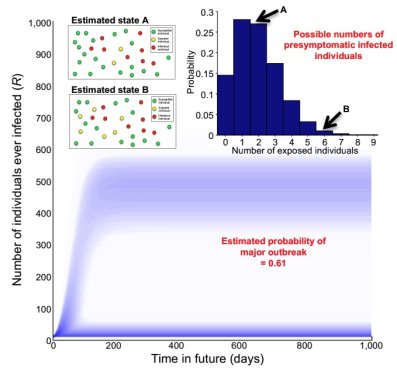Research: Early in an outbreak
 Our group is interested in developing mathematical models that can be used to assess the risk that early cases in an outbreak lead on to a major epidemic with a large number of cases, as opposed to the outbreak fading out with few cases. This research is based on the mathematical theory of branching processes, and we use two main approaches to estimate the probability of a major epidemic starting from a small number of cases (summarised here).
Our group is interested in developing mathematical models that can be used to assess the risk that early cases in an outbreak lead on to a major epidemic with a large number of cases, as opposed to the outbreak fading out with few cases. This research is based on the mathematical theory of branching processes, and we use two main approaches to estimate the probability of a major epidemic starting from a small number of cases (summarised here).
Recent work in the group has involved applying these methods to estimate the probability of a major epidemic in the context of models that include key features of real-world populations and outbreaks. We have considered models that account explicitly for differences in transmission between individuals of different ages, prior immunity due to previous infections, seasonal changes in transmission and an ongoing vaccination campaign. We have also been working on a framework for estimating the probability of a major epidemic that utilises information about within-host viral dynamics. This enables the effectiveness of interventions to be explored in greater detail compared to using population-scale models alone.
Key publications from our group relating to the earliest stages of an outbreak include:
- Hart WS, Amin J, Park H, Kitagawa K, Jeong YD, Kaye AR, Iwami S, Thompson RN. Effects of individual variation and seasonal vaccination on disease risks (2025) Nature Commun., 16:8471. (Available here)
- Evans A, Hart WS, Longobardi S, Desikan R, Sher A, Thompson RN. Reducing transmission in multiple settings is required to eliminate the risk of major Ebola outbreaks: a mathematical modelling study (2025) J. R. Soc. Interface, 22:20240765. (Available here)
- Hart WS, Park H, Jeong YD, Kim KS, Yoshimura R, Thompson RN, Iwami S. Analysis of the risk and pre-emptive control of viral outbreaks accounting for within-host dynamics: SARS-CoV-2 as a case study (2023) Proc. Natl. Acad. Sci., 120:e2305451120. (Available here)
- Southall E, Ogi-Gittins Z, Kaye AR, Hart WS, Lovell-Read FA, Thompson RN. A practical guide to mathematical methods for estimating infectious disease outbreak risks (2023) J. Theor. Biol. 562:111417. (Available here)
- Thompson RN, Southall E, Daon Y, Lovell-Read FA, Iwami S, Thompson CP, Obolski U. The impact of cross-reactive immunity on the emergence of SARS-CoV-2 variants (2023) Front Immun., 13:1049458. (Available here)
- Kaye AR, Hart WS, Bromiley J, Iwami S, Thompson RN. A direct comparison of methods for assessing the threat from emerging infectious diseases in seasonally varying environments (2022) J. Theor. Biol. 548:111195. (Available here)
- Lovell-Read FA, Shen S, Thompson RN. Estimating local outbreak risks and the effects of non-pharmaceutical interventions in age-structured populations: SARS-CoV-2 as a case study (2022) J. Theor. Biol. 535:110983. (Available here)
- Sachak-Patwa R, Byrne HM, Dyson L, Thompson RN. The risk of SARS-CoV-2 outbreaks in low prevalence settings following the removal of travel restrictions (2021) Comms. Med., 1:39. (Available here)
- Lovell-Read FA, Funk S, Obolski U, Donnelly CA, Thompson RN. Interventions targeting non-symptomatic cases can be important to prevent local outbreaks: SARS-CoV-2 as a case study (2021) J. R. Soc. Interface, 18:20201014. (Available here)
- Thompson RN, Gilligan CA, Cunniffe NJ. Will an outbreak exceed available resources for control? Estimating the risk from invading pathogens using practical definitions of a severe epidemic (2020) J. R. Soc. Interface, 17:20200690. (Available here)
- Thompson RN. Novel coronavirus outbreak in Wuhan, China, 2020: Intense surveillance Is vital for preventing sustained transmission in new locations (2020) J. Clin. Med., 9:498 (Available here)
Return to our Research page by clicking here.

